VW T2 transporter repair workshop manual
The Volkswagen means 2, understood officially as Transporter, Kombi or Microbus, or, informally, as Bus or Camper, is a forward control board van launched in 1950 because of the German automaker Volkswagen as the second automobile model.
As one of the
Volkswagen VW Transporter 1700 1800 2000 1972 1979 USED

Rare USED manual in good condition some small tears on the bottom back edge - Volkswagen VW Transporter 1700 1800 2000 1972 - 1979 Haynes Owners Service Repair Manual covers: Transporter derivatives. 1.7 litre (1679cc) 1.8 litre (1795cc) 2.0 litre (1970cc).Does NOT cover alternative bodies conversions produced by specialist manufacturers.Inside this manual you will find: Routine Maintenance tune-up procedures engine repair cooling and heating air-conditioning fuel and exhaust emissions control ignition brakes suspension and steering electrical systems and wiring diagrams.Haynes repair manuals can save you money on maintenance and repair bills. Step-by-step procedures and illustrations guide you through every job from basic maintenance and troubleshooting to complete teardown rebuild.
Volkswagen VW Commercial Type 2 Series 1973-1981
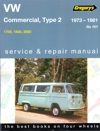
VW Volkswagen Commercial Type 2 Kombi series Repair Manual 1973 - 1981 Gregorys Get Other VW Car Repair Manuals click here Volkswagen VW Commercial Type 2 Series 1973 - 1981 Gregorys Owners Service Repair Manual covers the Type 2 Series Commercial Models.Engines covered: 1700cc 1800cc 2000cc (4 cyl) (Includes carburettor and Jetronic fuel systems Manual and Automatic).Covers everything you need to know step by step procedures hundreds of photographs and illustrations routine maintenance wiring diagrams repairs and overhauls and what tools to buy. Gregory s manuals are based on an actual vehicle stripdown and are researched and written by automotive engineers with vast experience.
Volkswagen Transporter Air cooled Petrol 1979 1982 UK
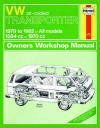
Volkswagen Transporter (Air-cooled) Petrol 1979 - 1982 manual covers: Transporter with air-cooled flat-four engines 1979 - 1982. 1.6 litre (1584cc) and 2.0 litre (1970cc) air-cooled engines. Covers both manual and automatic transmissions. Does NOT cover alternative body or camper conversions produced by specialist manufacturers. Does NOT cover water-cooled or Diesel engines.Inside this manual you will find: Routine Maintenance tune-up procedures engine repair cooling and heating air-conditioning fuel and exhaust emissions control ignition brakes suspension and steering electrical systems and wiring diagrams.Haynes repair manuals can save you money on maintenance and repair bills. Step-by-step procedures and illustrations guide you through every job from basic maintenance and troubleshooting to complete teardown rebuild.
Volkswagen VW Transporter 1954 1967 Service Repair Manual Brooklands Books Ltd UK
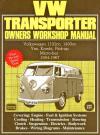
Get other VW transporter repair manuals here Volkswagen VW Transporter 1954 - 1967 Owners Workshop Manual is a Re-issue of Autobooks manual.Models Covered: Volkswagen Van Pick-Up 1200cc 1954 - 1964 Volkswagen Kombi Micro-Bus 1200cc 1954 - 1964 Volkswagen Van Pick-Up 1500cc 1963 - 1967 Volkswagen Kombi Micro-Bus 1500cc 1963 - 1967Contents: Engine Fuel System Ignition System Cooling and Heating System Clutch Transmission Rear Axle and Suspension Front Suspension Steering Braking System Electrical System Wiring Diagram for 1200 Transporter (30hp) Wiring Diagram for 1200 Transporter (34hp) Wiring Diagram for Transporter from August 1962 and Chassis Number 971.550 Wiring Diagram for Transporter with 12 Volt System (from August 1966 and Chassis Number 217.000.001) Bodywork .
Volkswagen VW Transporter 1600 1968 1979 Haynes Service Repair Manual
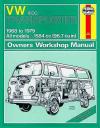
Get other VW repair manuals hereVolkswagen VW Transporter 1600 1968 - 1979 Haynes Owners Service Repair Manual covers: Transporter and derivatives 1968 - 1979 1.6 litre (1584cc)Does NOT cover the alternative bodies and conversions produced by specialist manufacturers.Inside this manual you will find: Routine Maintenance tune-up procedures engine repair cooling and heating air-conditioning fuel and exhaust emissions control ignition brakes suspension and steering electrical systems and wiring diagrams.Haynes repair manuals can save you money on maintenance and repair bills. Step-by-step procedures and illustrations guide you through every job from basic maintenance and troubleshooting to complete teardown rebuild.Information on Repair and Service ManualsNote that repair manuals are normally produced for models sold in a particular country.Differences in specification can exist between models sold in different countries and items such as installed engines can differ.Please check that the manual will cover your model before purchase and if you need more detail please contact us here..
How to Restore Volkswagen (bay Window) Bus
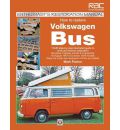
The only book currently available that comprehensively deals with the realities of restoring a VW Bay Window Bus. With over 1500 mainly colour photos it guides the reader clearly through body and chassis repairs paint work interior re-trimming and most common mechanical problems. The skills techniques and even the tools needed to complete these tasks are explained in jargon free language to ensure that even those enthusiasts with no previous restoration experience will feel confident in sorting out their Bus. An indispensable and unique guide for lovers of these fast appreciating classics. Integracar attempts to supply a diverse spectrum of maintenance guides. Although repair manuals can sometimes be produced for a range of countries and the cars put together for those countries. Hence not all service manuals may be best for your selected motor vehicle. If you have concerns whether or not a specific service manual is good for your vehicle please e-mail us hereHow to Restore Volkswagen (bay Window) Bus by Mark Paxton
Volkswagen Bay Transporter Haynes Restoration Manual
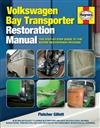
Hardcover - 320 pages - The VW Transporter is one of the most iconic vehicles on the roads today. Introduced in 1967 and continuing in production until October 1979 the Bay was the successor to the legendary split-screen Transporter and is the second of five generations of van so far given the Transporter name by VW.Even the poorest examples of the Bay now fetch significant money and imports from drier climes continue to appear on British roads so the case for restoring one of these hugely popular vehicles is increasingly attractive.Using the trusted Haynes practical step-by-step approach this all-colour manual follows the restoration of a 1979 Devon camper from beginning to end and provides expert advice on the problems likely to be encountered when working on vehicles that have seen over 35 years of use and in Britain as many years of rain salt and mud. This is the only guide to restoring (or part-restoring) a Bay you will ever need.
Volkswagen VW Official workshop manual Station wagon 1968-1979
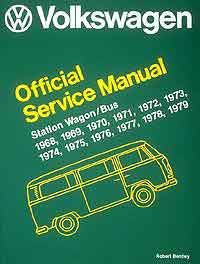
Volkswagen Station Wagon / Bus (Type 2) 1968 - 1979 Service Manual covers Station Wagons Panel Trucks Pickup Trucks Kombis and Campmobiles for the model years 1968 through 1979. This manual was created specifically to cover models built for sale in the United States and Canada.Technical features: Tune-up and oil change: specifications and procedures for all models up through the latest 1979 vehicles Troubleshooting replacing or repairing every component of the electrical system - with complete wiring diagrams Troubleshooting and repair of the electronic fuel injection system used on 1975 and later models Troubleshooting repairing and rebuilding the clutch manual transmission and automatic transmission Rebuilding the carburetor - including dual carburetors Rebuilding disc and drum brakes Rebuilding the front axle and steering gearbox Comprehensive engine repair and rebuilding data - including 1978 and later engines with hydraulic valve lifters Spark advance curves for all distributors-including the transistorized ignition system used on 1979 California models: Emission controls-incl
Original VW Bus
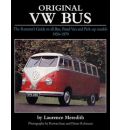
Original VW Bus by Laurence MeredithGet other VW repair manuals hereA comprehensive guide to original factory specification and equipment of VW Split-screen and Bay-window transporters. 265 photographs of 25 vehicles from Germany the UK and the USA illustrate not only the people carriers but the many variations panel van pick-up truck double-cab pick-up and highroof panel van. This is a re-issue of one of the most popular titles from the celebrated Original series accepted by classic car owners buyers and enthusiasts as the definitive source of advice on correct original and authentic specifications and equipment drawn from factory records parts lists and catalogues as well as the accumulated knowledge of the most respected restorers. Integracar tries to provide a large collection of owners guides. Nevertheless workshop manuals can sometimes be designed for numero
As one of the forerunners associated with contemporary cargo and traveler vans, the Type 2 provided rise to forward controls competitors in the us in sixties, like the Ford Econoline, the Dodge A100, plus the Chevrolet Corvair 95 Corvan, the second adopting the nature 2's rear-engine setup.
European competitors included the 1947-1981 CitroГғВ«n H Van, the 1959-1980 Renault Estafette, and the 1953-1965 FR layout Ford transportation.
Japanese manufacturers in addition launched the working platform in numerous configurations, such as the Nissan Caravan, Toyota LiteAce plus the Subaru Sambar.
Like Beetle, the van has received numerous nicknames worldwide, such as the "microbus", "minibus", and, because of its recognition during counterculture movement for the sixties, Hippie van/wagon, and still stays iconic for several hippies these days.
Brazil contained the past factory in the field that created the T2. Manufacturing in Brazil stopped on December 31, 2013, as a result of introduction of most stringent safety laws in the united states. This marks the end of an era aided by the rear-engine Volkswagens manufactured, which started in 1935 along with their means 1 prototypes.
Initial generation for the Volkswagen Type 2 is available as a van for services or as a men carrier. It had the distinctive 2 front windscreens therefore the V shape on forward panel. Worldwide it became affectionately known as the Bus, Barndoor, Kombi, Bullie, Microbus, Splitscreen, or Splitty, Samba, 21 Window and 23 Window, to-name just a few of their nick names. At first built until 1956 at Wolfsburg; from1956, it absolutely was built at new Transporter factory in Hanover. Sharing most components with all the VW Beetle, initial Transporters had been run on a 25Hp 1100cc Volkswagen air-cooled motor attached inside rear. This is upgraded into the 1200cc 30 Hp engine 1953. Until 1955 they were known as the Barndoor because of the huge rear system cover, in addition they had a set roof at the front, although the subsequent versions have the distinctive top or overhang over the 2 front windscreens.
Model variations
Through the 17 many years of manufacturing there have been a lot of models generated by VW, there is the basic panel van, a basic level Kombi or Bus is the 11-window. The Deluxe model featured eight back part house windows and two rear spot house windows, making it the 15-window. At the same time, Samba, formally called the sunroof Deluxe, included eight little skylight house windows giving they title associated with 23-window. From 1964 the larger tailgate meant a corner corner house windows were stopped, creating the post 1964 systems the 13-window and 21-window.
If you would like an even more detailed seasons by 12 months reputation for the iconic Splitty, be sure to see below where you will see a summary of key dates within the production of the Splitscreen model combined with the framework figures when it comes to relevant many years.
System types
Volkswagen provided a large number of products or alternatives of the VW Transporter, below are a few of the factory combinations:
Panel VanPanel van, a delivery van without side house windows or back chairs.
Walk-Through versions had solitary passenger and motorist seat, enabling you to ГўВҖВҳwalk throughГўВҖВҷ to your back.
Volume mind systems had dual passengers chair and single motorists chair
Tall roofing Panel Van, a distribution van with factory fitted lifted metal roofing.
Kombi, known in Germany as a Kombinationskraftwagen, with side house windows and detachable rear chairs, both a passenger and a cargo vehicle combined. Seating were simple to eliminate and also the rubberized floor pad managed to get very useful for efforts usage.
Coach, was a windowed van with additional comfortable indoor similar to a vehicle. Normally 3 rows of chairs, headlining all the way through, heating vents forward, middle and back.
Samba luxurious, had been the ГўВҖВҳup marketГўВҖВҷ form of the Bus, supplying roof windows, sliding sunlight roofing, 2 tone paint, dash-board time clock upgraded indoor trim.
Solitary taxi Pickup, sitting 3 right in front. Backside flat-bed load room with storage space lockers underneath. Has also been readily available with larger burden bed and extended mirrors.
Team taxi pick-up, usually a 6-seat form of the pickup. Understood in Germany as a Doppelkabine. Once again have under bed storing.
Westfalia , also known as a , "Westy". These came in a variety of finishes, using the option of an elevating roof. The interiors varied dependant on the entire year assuming the automobile is produced for European or United States Of America / Canadian export. More VW lovers begin to see the Westfalia camper since the ultimate conversion.
Commercial and camper sales
AmbulanceBecause of the type of the VW Transporter therefore the undeniable fact that VW were very relaxed about third party businesses changing them to approach utilizes, they truly became many different professional vehicles such as for example, refrigerated vans, hearses, ambulances, police vans, fire engines and ladder vehicles.
There was clearly additionally a little ГўВҖВҳarmyГўВҖВҷ of convertors throughout the world turning both vans and buses into campers. These varied drastically in high quality and luxury. A few of the well-known UNITED KINGDOM converters had been Danbury, Devon, Dormobile and Canterbury Pitt.
Manufacturing records, chassis data and techincal information
1950 Framework Numbers - 20000001 > 20008112
February in 2010 spotted initial panel vans roll from the production range, used in March by the Kombi and in might the first Buses or Microbuses. The engine dimensions ended up being 1131cc.
1951 Framework Numbers - 20008113 > 20020112
June this present year spotted the Samba coach roll from the production range and in December 1st Ambulances had been built.
1952 Chassis Data - 20020113 > 20041857
Pickup ModelAugust this year spotted the introduction of the popular pickup. This year additionally saw the development of synchronised 2nd, third, and 4th gears.
1953 Framework Data - 20041858 > 20070431
The only real major change this season had been the introduction of a more substantial 6 volt battery.
Jan 1954 to Feb 1955 Chassis data - 20070432 > 20117902
January 1954 saw the introduction of the 30Hp 1192cc motor.
1955 had been the end of production of the Barn Door design brands.
March 1955 to July 1955 Chassis Numbers - 20117903 > 20137605
The development of the 'post Barn Door designs'. The key changes had been, the development of a full width dash board, free wheel moved to behind the leading seating, gasoline container was moved to across gearbox and of course the development of the top within the forward windscreens. Another adjustment included the smaller 15" tires.
1956 Chassis Figures - 20-137606 > 191466
This present year spotted the change in framework data, nevertheless important modification ended up being the moving of automobile production from the delivery destination at Wolfsburg to a different factory in Hannover.
1957 Framework Numbers - 191467 > 191466
1958 Framework Numbers - 271676 > 371275
1959 Chassis Figures - 371276 > 490622
1958 and '59
Introduction of Crew taxi or Double Cab pickup. The bumpers are changed to a more robust design and all gears became fully synchronised.
1960 Chassis Numbers - 490623 >632584
This year the 34 Hp system is introduced and flashing signs changed the semaphore.
1961 Framework Numbers - 632585 > 802985
1962 Chassis Figures - 802986 > 971550
Petrol measure becomes standard fitment, a recommended 42 Hp system was available additionally the front workbench chair is designed to hinge ahead.
1963 Chassis Data - 971551 > 1144281VW
1500cc engine was introduced, the front signs are created bigger into 'fish attention design'. Panel vans are available available with a sliding door and the tailgate was enlarged as standard.
1964 Chassis Figures - 1144282 > 1328871
You can now purchase patterned chair protects, the windscreen wipers are greatly improved along with the heat.
1965 Framework Data - 215000001 > 215176339
The 1500cc system is enhanced to offer 44 Hp. A two rate wiper engine had been introduced along with a foot switch to dip the headlights. The pickup and crew cabs had a larger back window introduced.
1966 Framework Figures - 216000001 > 216179668
Eventually 12 volt electrics had been launched.
1967 Chassis Figures - 217000001 > 217148459
The end of the Splitscreen production.
Between 1950 and 1967 when creation of the Splitscreen design ended the production range had rolled on 1,477,330 vehicles. A version had been manufactured in Brazil by VW until the 1990's.
The concept for Type 2 are credited to Dutch Volkswagen importer Ben Pon. Pon visited Wolfsburg in 1946, going to buy Type 1s for import into Netherlands, where he spotted an improvised parts-mover and knew things best is feasible making use of the stock Type 1 pan. He initially sketched the van in a doodle dated April 23, 1947, proposing a payload of 690 kg and putting the driver in the extremely forward. Production would have to wait, however, as the factory was at capacity making the sort 1.
When capability freed up, a prototype known internally because the kind 29 was manufactured in a brief 90 days. The stock means 1 cooking pan proved to be too weak therefore the model put a ladder chassis with product body building. Coincidentally the wheelbase ended up being exactly like the kind 1's. Engineers used again the decrease equipment from the means 81, allowing the 1.5 ton van to utilize a 25 hp flat four motor.
Even though aerodynamics of the earliest prototypes were poor, engineers utilized the wind tunnel within Specialized University of Braunschweig to enhance the design. Easy modifications such as for example splitting the windshield and roofline into a "vee" assisted the production kind 2 secure Cd=0.44, surpassing the nature 1's Cd=0.48. Volkswagen's new ceo Heinz Nordhoff approved the van for manufacturing on 19 might 1949 and the earliest manufacturing design, today designated kind 2, rolled off the assembly-line to debut 12 November. Only two versions are offered: the Kombi, therefore the retail. The Microbus had been included in May 1950, joined up with by the luxurious Microbus in Summer 1951. In all 9,541 Type 2s were manufactured in their particular very first seasons of production.
An ambulance design was added in December 1951 which repositioned the gasoline container while watching transaxle, put the free tire behind the front chair, and added a "tailgate"-style rear home. These functions became standard in the Type 2 from 1955 to 1967. 11,805 Type 2s had been built-in the 1951 model seasons. These were joined by a single-cab pickup in August 1952, plus it changed the least associated with Type 2s until all are heavily customized in 1968.
Unlike various other rear engine Volkswagens, which evolved continuously as time passes but never ever spotted the development of all-new brands, the Transporter not just evolved, but is completely modified periodically with variations retrospectively referred to as models "T1" to "T5". However, best years T1 to T3 is seen as right linked to the Beetle.
The nature 2, combined with the 1947 CitroГғВ«n H Van, were among the first 'forward control' vans where motorist was placed over the front side roadwheels. They going a trend in Europe, where in actuality the 1952 GM Bedford CA, 1958 RAF-977, 1959 Renault Estafette, 1960 BMC Morris J4, and 1960 Commer FC additionally made use of the concept. In the usa, the Corvair-based Chevrolet Corvan cargo van and Greenbrier passenger van moved in terms of to copy the nature 2's rear-engine design, utilising the Corvair's horizontally opposed, air-cooled system for power. Excluding the Greenbrier and various 1950sГўВҖВ“70s Fiat minivans, the nature 2 stayed unique in-being rear-engined. This is a disadvantage for the early "barndoor" Panel Vans, which may maybe not easily feel loaded through the rear due to the fact motor address intruded on interior area, but usually beneficial in grip and interior noise.
The sort 2 was readily available as a:
Panel van, a distribution van without part microsoft windows or rear seats.
Double-door Panel Van, a delivery van without side house windows or rear chairs and cargo doors on both sides.
Tall roofing Panel Van, a delivery van with lifted roofing.
Kombi, from German: Kombinationskraftwagen, with part microsoft windows and detachable backside seating, both a traveler and a cargo automobile combined.
Bus, also called a Volkswagen Caravelle, a van with an increase of comfortable inside similar to traveler automobiles since the 3rd generation.
LotaГғВ§ГғВЈo, a version unique to Brazil, with 6 front-hinged doors the traveler area and 4 bench-seats, catering on supplemental public transport portion. Available from 1960 to 1989, in both the split-window and "clipper" bodystyles.
Samba-Bus, a van with skylight microsoft windows and cloth sunroof, first generation only, also called a luxurious Microbus. These people were promoted for touring the Alps.
Flatbed vehicle, or solitary taxi, in addition available with larger burden bed.
Team cab pick-up, a flatbed truck with extended taxi and two rows of seating, also called a Doka, from German: Doppelkabine.
Westfalia camping van, "Westy", with Westfalia roof and interior. Included recommended "pop up" top.
Adventurewagen camping van, with high roofing and camping units from Adventurewagen.
Semi-camping van that can in addition be put as a traveler vehicle and transporter, losing some camping conveniences. "Multivan" or "Weekender", offered by the third generation on.
Besides these factory variations, there were a variety of third-party conversion rates offered, some of that have been provided through Volkswagen dealers. They included, but were not limited by, refrigerated vans, hearses, ambulances, authorities vans, fire engines and ladder trucks, and camping van conversion rates by organizations apart from Westfalia. There have been even 30 Klv 20 rail-going draisines designed for Deutsche Bundesbahn in 1955.
In South Africa, it really is generally a well-loved difference of the frozen dessert van. The mere sight of 1 sparks the familiar rhyme: we shout, We shout, We all scream for Ice-Cream!
First generation
Volkswagen Means 2
Volkswagen Typ 2 belated split-screen variation April 1966.JPG
1966 Volkswagen Kind 2
Analysis
Maker Volkswagen
Production 1950ГўВҖВ“1967
1950ГўВҖВ“1975
Assembly Wolfsburg, Germany
Hanover, Germany
SГғВЈo Bernardo do Campo, Brazil
Melbourne, Australia
Body and chassis
Class Light commercial vehicle
Human body style 5-door panel van
5-door minibus
2-door pickup
3-door pickup
Layout RR layout
System Volkswagen Team T1 platform
Powertrain
Engine 1.1 L B4
1.2 L B4
1.5 L B4
1.6 L B4
Proportions
Wheelbase 2,400 mm
Length 4,280 mm
Circumference 1,720 mm
Height 1,940 mm
The initial generation of the Volkswagen kind 2 because of the separate windshield, informally labeled as the Microbus, Splitscreen, or Splittie among modern-day lovers, is created from 8 March 1950 through end of this 1967 design 12 months. From 1950 to 1956, the T1 had been built in Wolfsburg; from 1956, it absolutely was built during the brand-new Transporter factory in Hanover. Like the Beetle, initial Transporters made use of the 1100 Volkswagen air-cooled engine, an 1,131 cc, DIN-rated 18 kW, air-cooled flat-four-cylinder 'boxer' engine mounted when you look at the backside. This was enhanced into the 1200 ГўВҖВ“ an 1,192 cc 22 kW in 1953. A greater compression ratio became standard in 1955; while a unique early type of the 30 kW engine debuted solely from the Type 2 in 1959. This motor turned out to be so uncharacteristically troublesome that Volkswagen recalled all 1959 Transporters and changed the machines with an updated form of the 30 kW motor. Any 1959 models that hold that very early motor these days were true survivors. Considering that the system was completely stopped at the outset, no section are ever before offered.
1954 Volkswagen Barndoor Solitary Cab
The first variations of T1 until 1955 were often called the "Barndoor", due to the enormous backside system cover, while the subsequent versions with a slightly modified body, small system bay, and 15" roadwheels instead of the initial 16" your become today called the T1b. From 1964 model season, when the rear door is made wide, the car might be described as the T1c. 1964 in addition spotted the development of an optional sliding door the passenger/cargo location as opposed to the outwardly hinged doors typical of cargo vans.
In 1962, a heavy-duty Transporter had been launched as a factory choice. It showcased a cargo capability of 1,000 kg rather than the previous 750 kg, modest but broader 14" roadwheels, and a 1.5 Le, 31 kW DIN engine. This was therefore successful that just a year later on, the 750 kg, 1.2 L Transporter ended up being stopped. The 1963 design season launched the 1500 system ГўВҖВ“ 1,493 cc as standard products towards the US market at 38 kW DIN with an 83 mm bore, 69 mm stroke, and 7.8:1 compression proportion. Once the Beetle got the 1.5 L system the 1967 model year, its power is increased to 40 kW DIN.
1966 Volkswagen Kombi
German manufacturing ended following the 1967 model season; but the T1 however had been built in Brazil until 1975, when it had been altered with a 1968ГўВҖВ“79 T2-style front end, and huge 1972-vintage taillights to the alleged "T1.5" and produced until 1996. The Brazilian T1s were not exactly the same as the past German products, though they sported some characteristic options that come with the T1a, for instance the cargo doorways and five-stud 205 mm Pitch Circle Diameter wheels. Wheel monitors diverse between German and Brazilian production and with 14-inch, 15-inch and 16-inch wheel alternatives but generally front track varied from 1290 mm to 1310 mm and rear track from 1370 mm to 1390 mm.
VW coach means 2, hippie colors
Among US fans, it is common to mention into the different models by the range their particular house windows. The basic Kombi or Bus could be the 11-window with a split windshield, two forward cabin door windows, six rear side house windows, and another rear screen. The luxurious model showcased eight back part windows as well as 2 back place house windows, which makes it the 15-window. At the same time, the sunroof luxurious with its further eight smaller skylight windows is, correctly, the 23-window. From 1964 design 12 months, using its wide rear door, the trunk place house windows are stopped, making the second two the 13-window and 21-window correspondingly. The 23- and later 21-window variants each bring the nickname 'Samba', or perhaps in Australia, officially 'Alpine'.
Body designs and design variations
Volkswagen provided a massive selection of versions or variations of VW Transporter, here are a few associated with the factory combinations:
T2Panel van, a delivery van without part windows or backside seating.
Walk-Through brands had solitary traveler and driver seat, enabling you to ГўВҖВҳwalk throughГўВҖВҷ towards the rear.
Bulk head systems had two fold passenger chairs and single drivers seat
Tall roofing Panel Van, a shipments van with factory installed increased fibreglass roof.
Kombi, known in Germany as a Kombinationskraftwagen, with part house windows and detachable rear chairs, both a passenger and a cargo automobile blended. Seating had been simple to eliminate and also the rubber floor pad managed to get really practical for efforts use.
Coach, is a windowed van with additional comfortable internal reminiscent of a car or truck. Normally 3 rows of chairs, headlining throughout, warming vents forward, middle and rear.
Deluxe, is the ГўВҖВҳup marketГўВҖВҷ version of the Bus, but had been available with recommended extras, including chrome bumpers, belated brands had headlamp washers! Rubber trim on bumpers, 2 tone paint etc
T2Single Cab Pickup, seated 3 right in front. Backside flat bed burden room with storage lockers below. Was also offered with larger burden sleep and stretched mirrors.
Crew cab pick-up, typically a 6-seat form of the pickup. Known in Germany as a Doppelkabine. Again have under sleep storage, however with modest access doors. Ended up being available with one or two back traveler doorways.
Westfalia , also referred to as a , "Westy". These emerged in many different finishes, with all the choice of an elevating roof, which used the deluxe coach sunroof aperture. The interiors diverse regarding season and if the automobile was produced for European or American / Canadian export. Many VW lovers see the Westfalia camper whilst the ultimate transformation.
Commercial and Camper conversions
Due to the design of the VW Transporter additionally the fact that VW had been extremely relaxed about 3rd party organizations converting all of them to approach utilizes, there became multiple expert motors such as for instance, refrigerated vans, hearses, ambulances, authorities vans, fire engines and ladder vehicles.
There clearly was additionally a small ГўВҖВҳarmyГўВҖВҷ of convertors throughout the world switching both vans and buses into campers. These varied significantly in high quality and deluxe. Some of the popular British converters were Danbury, Devon, Dormobile, Canterbury Pitt, and Viking etcetera. Just Kampers provide outstanding variety of camper and camping internal section for conversion and repair.
Manufacturing background and model developing
Aug 1967 Saw the ГўВҖВҳBay WindowГўВҖВҷ design change the ГўВҖВҳSplit ScreenГўВҖВҷ. It was a radical rethink with modifications such basketball joint front side suspension, instead of king and link pin. Separate rear suspension, also referred to as IRS, had been installed as opposed to decrease cardboard boxes and swing-arms, a one-piece windscreen, wind down cab windows. Motors are fitted with a ГўВҖВҳback barГўВҖВҷ to stabilize the system. Indeed every system panel and technical part was altered.
1969 new-front axle, gasoline container is hidden behind a bulkhead, door handles are changed.
1970 Minor adjustment took place like the fuse field, otherwise an uneventful seasons.
1971 > 72 Introduction of front disk brake system and new rear brakes. Additionally the introduction of the little 5 stud rims with flat hubcaps.
1972 Bodywork modifications included flared forward and back wheel arches. High back lighting, with reverse lights as an optional additional. This year in addition spotted the introduction of the 1.7L level Type 4 design system with twin carbs. There were some motors with very early design arches and disc brakes. A number of the late ГўВҖВҳ72 motors posses highest forward signs and ГўВҖВҳ73 on front panels but nevertheless have the wrap around design front side and rear bumpers.
1973 Huge model revamp. The ГўВҖВҳwrap aroundГўВҖВҷ design bumpers are replaced with the square style. The leading indicators were relocated up to the brand new grille. Changes were additionally made to leading arches and cab flooring, accelerator linkage, steering container and many various other progress like the 1800cc system. Forward brake system had been again enhanced.
1974 principal adjustment are enhanced gear linkage, the indicators and wash wipe switches had been enhanced, combined with the sliding home and lock.
1975 just larger change ended up being the cab doors were a ГўВҖВҳone year onlyГўВҖВҷ design.
1976 modifications towards cab doors / hinges. The accelerator linkage and pedal are also refurbished.
1977 No notable modifications.
1978 the primary change was in August 1978 as soon as the 2000cc machines had new cylinder heads while the temperature exchangers are redesigned.
1979 Sadly saw the end of ГўВҖВҳBay WindowГўВҖВҷ production in Germany.
T2Quick guide to let recognition of VW T2 Transporters
'Early BaysГўВҖВҷ 1967 > 1971 recognized by tiny rear lighting, smooth wrap-around bumpers and lower installed forward indicators above the bumper.
Crossover - 'Late 71 BaysГўВҖВҷ Flared wheel arches but nonetheless have actually little rear lighting and drum brakes.
Crossover - 'later 72 BaysГўВҖВҷ minimum front side signs, very early wrap-around bumpers, but tall back lighting, disc brake system, supported gearbox as well as the alternative of servo brakes.
'Late ГўВҖВҳBaysГўВҖВҷ 1973 > 1979 they are recognized by big back lighting, grooved non-wrap around bumpers and high-mounted front side signs either side of the barbeque grill. They also have the flared wheel arches at all times.
Bay-window framework numbers explained
The framework quantity, or automobile recognition Number, are found stamped on an aluminum plate either behind leading chairs or in the motor bay. An illustration framework amounts might see: 229 375 250...
The first digit for the chassis number, '2', indicates that is a kind 2.
The 2nd digit regarding the VIN, again '2', denotes the vehicle design. Which model have you got?
1. Panel van
2. Microbus 7/9 seater
3. Kombi for example. van with microsoft windows
4. Deluxe microbus 7/9 seater
6. Pickup
7. Crewcab
The next digit associated with chassis quantity presents the season
1968 218 000 001 > 218202251
1969 219 000 001 > 219300000
1970 210 2000 001 > 2102300000
1971 211 2000 001 > 2102300000
1972 212 2000 001 > 2102300000
1973 213 2000 001 > 2102300000
1974 214 2000 001 > 2102300000
1975 215 2000 001 > 2102300000
1976 216 2000 001 > 2102300000
1977 217 2000 001 > 2102300000
1978 218 2000 001 > 2102300000
1979 219 2000 001 > 2102300000
T2 Bay Window engine figures
The system amounts can be bought stamped on top of this crankcase, centrally over the crankshaft pulley in the type 1 or type 2 machines. And stamped at the top of crankcase above the soothing fan in the kind 4 engine.
T2 Bay Window engine sort
There were two motor choices which were initially fitted to the VW Transporter between 1967 and 1979.
The initial had been the Type 2 1600cc engine, which will be exactly the same as the nature 1 Beetle motor except it offers an additional motor installing powering the crankcase. Frequently named an upright motor. The next option very first appeared in 1972 and also this was the kind 4 motor that has been marketed in three sizes, 1700, 1800 and 2000cc. Commonly called a Pancake or Type 4 motor.
Kind 1 and 2 Engines
SIGNAL CC BHP RECORDS
B 1600 47 Solitary Interface
advertising 1600 50 Twin Interface
AS 1600 50 Twin Port
Type 4 Machines
SIGNAL CC BHP NOTES
CA 1700 66 Kind 4
CB 1700 66 Kind 5
CD 1700 66 Type 6
AP 1800 68 Type 7
CJ 2000 70 Means 4
GD 2000 70 Kind 4
GE 2000 70 Means 5
T2 Bay-window paint codes
Exactly what color try my VW? Although many VW Campers started off all white and transformation businesses resprayed underneath 1 / 2 along with the consumer chose there were many factory colour alternatives too. Below are the colour offered by Volkswagen, once the Transporter is manufactured.
Paint codes
L87 Pearl-white
L90D Pastel Light
L91Z Atlas White
L282 Lotus Light
L581 Cloud White
L567 Ivory
L20B Brilliant Lime
L555 Titian Red
L30B Kansas Red
L30H Montana Red
L31A Senegal Red
L31H Chianti Red
LH3A Fox Red
L11H Sierra Yellow
L20A Marino Yellow
L21A Chrome Yellow
L62H Bali Yellow
L60D Elm Green
L61B Sumatra Green
L63H Sage Green
L512 Velvet Green
L610 Delta Green
L50H Brilliant Blue
L50K Neptune Blue
L53D Niagra Azure
L53H Orient Blue
L57H Reef Blue
LE1M Mexico Beige
L13A Dakota Beige
L13H Ceylon Beige
L91D Kansas Beige
L620 Savannah Beige
L12A Panama Brown
L87Z Agate Brown
LH8A Day Brown
L041 Ebony
L345 Light Grey
Information is correct into the best of your understanding, so we accept no obligation for erroneous information.
Overseas production
Exactly what taken place when production stopped in Hannover in 1979? These are generally still manufactured in Brazil nowadays and offered by Danbury near Bristol!
Brazil possess manufactured the Kombi from Splitscreen in 1950s, to a version of the German Bay Window, well-known distinctions being a slightly higher steel roof, an increasing bulge regarding the taxi doorways and in the past few years the 1600cc air-cooled engine ended up being changed in December 2005, with a 1400cc water-cooled system and also as itГўВҖВҷs water-cooled, they have a black synthetic radiator cover on the forward panel.
Mexico furthermore created the Bay Window, again at first as a 1600cc air-cooled system plus in the early 1990ГўВҖВҷs installing a water-cooled 1800cc 90 bhp fuel-injected system.
As Brazil nevertheless creates about 35,000 Kombis a-year, this makes it a really preferred neighborhood vehicle and longest manufacturing run automobile in the world.
Where else has got the T2 bay-window already been built? In KDF or perhaps in neighborhood industrial facilities they are integrated:ГўВҖВЁ
Germany - August 1967 to August 1979
Mexico - 1970 to 1996
Brazil - 1976 whilst still being in production nowadays
Argentina - 1981 to 1986
Australian continent - 1968 to 1979
Landmark production years
August 1967 sees the very first ГўВҖВҳBay WindowГўВҖВҷ Transporter manufactured in Germany within Hannover plant
1968 views the 2,000,000th Transporter roll from the German production lines
1977 views the 4,500,000th Transporter roll from the German manufacturing lines
August 1979 manufacturing stops in Germany to permit the ГўВҖВҳT25 or T3 is produced